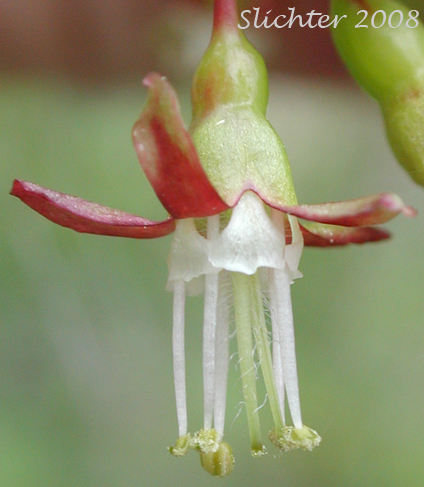 The photo at right shows a close-up of the flower of straggly currant as seen at the Conboy Lake NWR headquarters to the southeast of Mt. Adams........May 10, 2008. Note the glabrous filaments and the hairy styles.
The photo at right shows a close-up of the flower of straggly currant as seen at the Conboy Lake NWR headquarters to the southeast of Mt. Adams........May 10, 2008. Note the glabrous filaments and the hairy styles.
Characteristics:
Straggly currant is also called wax currant or coast black currant. It is a deciduous, spreading shrub with many branches from 1.5-3 meters high. It commonly may have several thicker branches which may arch over. The bark is gray to brownish and unarmed except where the leaves attach. The younger twigs are whitish or purplish gray and 2-3 mm thick. The 1-3 spines found at each leaf node are downward curving and 10-20 mm long. The leaves are small, 2-6 cm wide, and simple with palmate venation. The blades are ovate in shape and have 3-5 lobes with toothed margins. The petioles may be shorter to slightly longer than the blades.
The inflorescence is a drooping, slender, 2-4 flowered raceme which arises from the leaf axils. Individual flowers are conical or shallowly-spreading bell-shaped. The calyx lobes are narrowly oblong, obtuse, or rounded and 5-7 mm long The petals are wedge-shaped to obovate, 1.5-2.5 mm long, and about less than half as long as the calyx lobes. The stamens are longer than the calyx by more than 1-2 mm. The berries are reddish purple, occur in 2s or 3s, rounded, and about 1 cm in diameter.
Straggly currant is found in moist open woods and hillsides, and is common along streams.
Straggly currant may be found from southern British Columbia south to California. It is found eastward to southwestern Alberta.